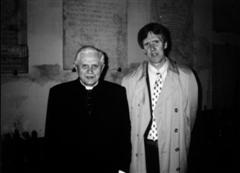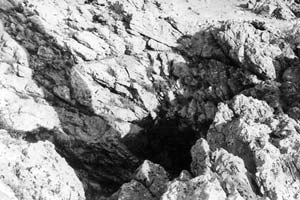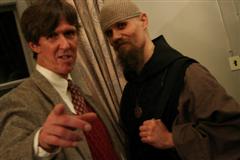Interview
E. Michael Jones, Ph.D, the author of two books on the apparitions of the Gospa in Medjugorje
Contribution to an objective history of the occurrences in Herzegovina
The journalist Michael Jones, Ph.D, former editor of the Catholic Fidelity magazine, and since 1995 the editor of Culture Wars, investigated the phenomenon of the apparition of the Gospa in Medjugorje for a number of years. The results of his research were published in his two books seeking an answer to the question of whether the alleged apparitions of Mary in Medjugorje were a visitation from heaven, or the sinister projection of a collective guilty conscience. The author places the occurrences in Herzegovina in the context of world events and tells us that "in 1980 the sense that the established order was coming to an end in eastern Europe was in the air." If the communist repression can be represented as a concrete lid placed over the pits in Herzegovina where innocent people were killed then, Michael Jones tells us, "the death of Tito and the election of a Polish pope and the rise of Solidarity meant that the communist lid was about to be removed from Yugoslavia."
The state secretary of the Holy See , cardinal Tarcisio Bertone, has stated recently that ”the phenomenon of Medjugorje should be reconsidered.” The judgement from Rome has prompted much speculation . Accoding to the statement of thearchbishop of Sarajevo , Vinko Puljic, as reported by the Zagreb press, The Bishops' Conference of Bosnia and Herzegovinahas not discussed Bertone’s position. ”The phenomenon of Medjugorje exceeds our authority. As soon as the Holy See reaches a decision and assigns us our task , we shall consider what we are to do. There’s no need for any speculation until we receive concrete instructions,” said the archbishop of Sarajevo, Vinko Puljic, according to the Vecernji List newspaper (March 21, 2008).
It was the results of Michael Jones’s investigations of the apparitions of the Queen of Peace, the contribution of one foreigner to an accurate, non-ideological history of the events in Herzegovina, which prompted us to ask him to grant us this interview.
- How is it that you are so much interested in the history of Yugoslavia and the states
established after its disintegration?
Jones: Twenty years ago I decided to go to Medjugorje to write an article on the apparitions for Fidelity magazine. During the mid-'80s America had been flooded by a lot of expensively printed, full-color propaganda about the "seers," but I felt that the story they were telling did not add up. Add to that the fanatical behavior of the followers of the Gospa over here, and you had a situation which needed to be clarified. My readers kept asking me about Medjugorje, and so I felt that I had to investigate the phenomenon myself. That's why I went to Medjugorje in May of 1988. When I got there, one of the first things I did was to meet with Bishop Pavao Zanic at his residence in Mostar. He told me in no uncertain terms that the apparitions were a hoax. He also told me that he had met with Cardinal Ratzinger, who agreed with him, and the pope, who said nothing. This meeting led to contacts which led to the first book Medjugorje: The Untold Story, which was originally a long, two-part article, which appeared in the September and October 1988 issues of Fidelity. The article caused a sensation when it appeared. It was the first time anyone said anything negative about Medjugorje. I became interested in the history of Yugoslavia as a result of my research on Medjugorje. This interest intensified after the civil war broke out in the '90s because one of the claims of the so-called "Gospa" and her followers was that peace among ethnic groups in Yugoslavia was the proof of the authenticity of the apparitions of Our Lady Queen of Peace.
- How often have you had a chance to visit B-H, Serbia and other ex-Yugoslavia republics, and for what reasons?
Jones : I was in Yugoslavia once in 1988, and then I visited Croatia and B-H three more times in 1996. On two of those occasions I was involved in the filming of documentaries on Medjugorje.
- In explaining the apparitions of the Gospa in Medjugorje you use the historical and geographical facts drivingYugoslavia into the civil war. Could you explain in a few sentences, for our readers who haven't had a chance to read your book The Medjugorje Deception, your position towards the apparitions of the Gospa in Medjugorje?
Jones: The so-called "apparitions" of Medjugorje were a creation of the rebellious province of Croatian Franciscans near Mostar. They then became part of the Reagan's administration's campaign to bring down the Soviet Union. I consider the apparitions a hoax.
- How is it possible that the kids made such a widespread propaganda?
Jones: First of all, the "kids" did not create this apparition. Medjugorje was a creation of the
rebellious province of the Croatian Franciscans in the area around Medjugorje and Caplijna. They had been in a battle with the local bishop over control of a number of parishes and still are as far as I know. The "apparitions" took place one year after Tito's death.
When the Franciscans realized the huge crowds they were drawing could be exploited in their battle with the bishop, they took control of the children and the apparitions. The "apparitions" then got integrated into the failing Charismatic renewal movement, and finally they became part of the last phase of Reagan's anti-Communist crusade. The "kids," however, remained puppets of the Franciscans throughout the entire period.
- How would you explain that only one, although a terrible, event, the massacre at Surmanci, was an initial capsule to the civil war in Yugoslavia?
Jones: I don't think that the events at Surmanci created the civil war in Yugoslavia. I think that the guilt in the village over the 1941 massacre made the residents of Medjugorje more likely to go along with the Franciscans' schemes.
- In your book The MedjugorjeDeception you write: "What strikes you even more than the spatial propinquity of atrocity and apparition is the eerie coincidence of dates. Just about everything of significance in Balkan history seems to happen in June. The defining moment of Serbian history, the Battle of Kosovo Pole, took place on June 28, 1389. The assassination of Archduke Ferdinand in Sarajevo, the event that led to the outbreak of World War I, occurred on June 28, 1914, as sort of weird symbolic commemoration of the Battle of
Kosovo Pole. The Croatians declared their independence from Yugoslavia on June 25, 1991, which corresponded to the day to the tenth anniversary of the apparitions of Medjugorje, which took place on the fortieth anniversary of the Massacre at Surmanci." What is your explanation of this coincidence of dates?
Jones: I have no explanation for this "eerie coincidence." That's why I call it an "eerie coincidence."
- Where did you find the material for writing the books on Medjugorje?
Jones: The material on Medjugorje all came from personal, first hand research.
I was the one who located "Manda" in Bavaria and I was the one who located Marijan Pehar in San Francisco. The material on the history of Yugoslavia came from library research.
“Ustasha functionaries showed up at the predominantly Serbian village of Prebilovci on the eastern side of the Neredva and other Serb enclaves and announced to the villagers that they were all going to be deported to Belgrade. The Serbs were told they were going to be reunited with the Serbian fatherland, a prospect that took the edge off their anger and anxiety. So the Serbs showed up in their best clothes as they marched off to the train station, to become one more dislocated group in a Europe that seemed full of dislocation and people who went off in trains and never came back. The Serbs of Prebilovci were herded together with other Serbs from the western part of Herzegovina and eventually six carloads of them were sent off on a train that was supposedly to take them back to Belgrade. The train ride was much shorter than expected, at least as expected by the Serb passengers, who were ordered out of the six cars they occupied at a town called Surmanci, on the west bank of the Neredva, and marched off into the hills never to return.
Roughly three months later, Bishop Zanic’s predecessor, Aloysije Misic, ordinary of Mostar, the ornate Ottoman town a few train stations upstream from Surmanci, wrote to Cardinal Stepinac, primate of the once and future Yugoslavia, a man who would end up in prison at the hands of Tito’s revolutionary justice, and told him of disquieting reports of atrocities perpetrated against the Serbs in his diocese. “Men are captured like animals,” Misic wrote, “they are slaughtered, murdered; living men are thrown off cliffs....From Mostar and from Capljina a train took six carloads of mothers, young girls, and children...to Surmanci....They were led up the mountains and...thrown alive off the precipices....In...Mostar itself they have been found by the hundreds, taken in wagons outside the town and then shot down like animals.” Eventually around 600 Serbs, including priests, women, and children, were thrown into the pit above Surmanci and then, after throwing hand grenades in on top of them, the Ustashe thugs buried them, most probably still alive.”
Michael Jones, the first chapter in The Medjugorje Deception, copies of which can be obtained at culturewars.com
- Have you saved the documentaries on Medjugorje?
Jones: I have a documentary called Visions on Demand, which is now in DVD format. The other documentary was produced by Channel Four in England and I don't have a copy of that.
- What do you think about the fact that there are few non-Serbian publications writing about the 1941 genocide against Prebilovci and the Serbs in NDH?
Jones: The material on the Serbia genocide--for example, the book by Avro Manhattan--was fatally compromised by its use as propaganda for the Tito regime. Bishop Peric, the
current bishop of Mostar-Duvno, told me that all of the diocesan archives had been loaded
into trucks by Tito's communists and never seen again. As a result, it has been extremely difficult to write an accurate and objective history of his period. He told me that he would like to cooperate with the Serbs in producing an accurate, non-ideological history of the World War II period.
- Can Prebilovci and Medjugorje become places for interreligious dialogue, perhaps even
dialogue between intellectuals of Serbian and Croatian origin aiming at creating of a
better understanding between them and sharing of scientific experiences and opinions?
Jones: Yes, see my answer to the above question. Both the late Bishop Pavao Zanic and the current bishop of Mostar, Ratko Peric, have been courageous defenders of the truth. Both men
have denounced Medjugorje as a fraud, and both men have suffered for their defense of the
truth. I think Bishop Peric would be an ideal partner in any Serb-Croat dialogue.
In 1979 E. Michael Jones ( South Bend, Indiana) received a Ph. D. in American literature from Temple University. In 1981 he created and designed Fidelity magazine and was its editor until 1996. In 1995 he founded Culture Wars magazine where he has been editor ever since . He is the author of fifteen books, including two on Medjugorje in Herzegovina, the village which became internationally known as a result of the apparitions and messages of the Gospa: The Medjugorje Deception: Queen of Peace, Ethnic Cleansing, Ruined Lives (South Bend, IN: Fidelity Press, 1997) and Medjugorje: The Untold Story (South Bend, IN: Fidelity Press, 1988). Jones has given around one hundred lectures since 1980 throughout the USA, in Estonia, Poland, Austria, Czech Republic, and England.
Michael Jones, Ph.D., was interviewed by Saša Važić, a freelance journalist from Belgrade
Published at www.prebilovci.net in March 2008



